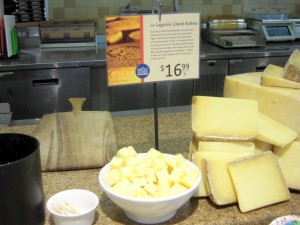Back to: Sample & Demonstrate Your Way To Higher Sales
Active Sampling
Active sampling means that there is an employee either handing out samples or attending a sampling station. In addition to offering samples, they also provide information about what customers are trying.

PRO:
- Better customer engagement.
- Increases the likelihood of purchase through the personal connection made between customer, employee, and product.
- Allows you to feature products on your menu that may not be getting enough attention.
CON:
- Higher labor cost than passive sampling.
- Requires some set-up and clean-up.
A great example of Active Sampling is how Whole Foods has staffed sampling stations throughout their stores on busy days. From the produce and meat to the cheese and wine departments – some even joke that you can have a full dinner at Whole Foods in just eating all the samples.
You’ll often see restaurants in mall food courts doing active sampling. Someone handing out bites of their Kung Pao chicken on toothpicks. With so many choices, sometimes this can be a good way to snag the undecided customer.
Passive Sampling
When samples are left for customers to help themselves. Typically unattended except for refilling and maintenance.

A good example of Passive Sampling is how Whole Foods offers slices of fruit, vegetables, cheese, and other items on sampling trays located at the product. Customers can sample and immediately pick-up the item if they like it.
PRO:
- With signage and proper set-up, it basically runs itself.
- Requires little labor.
CON:
- Customers may not understand why you’re sampling and may “miss the point.”
- Passive sampling stations can get messy quickly.
- Passive demonstrations (not intended to be passive) often can confuse more than they help, frustrating customers.
Good Examples of Passive Demonstrations
Apple Stores are a big showroom full of operational equipment, they allow you to try all of their products before you buy.

Electronic stores that sell TVs and sound systems – in addition to having have special rooms with systems hooked up to listen to – have every model of TV showing images so you can compare image quality.

What’s interesting about these passive demonstrations is that they are only “sort of” passive. There is often a smart sales person waiting to convert passive into active if the customer had any questions.
We recommend scheduling staff for Active Sampling and Demonstrations. You can’t count on “down time” as a time for sampling. In fact, busy times are often the perfect time for sampling. It makes the wait in line feel shorter for customers if they are offered something new (for free), and provides the opportunity to up-sell premium and featured products.
